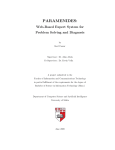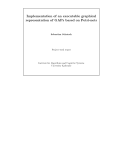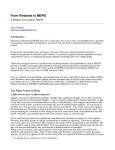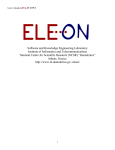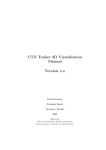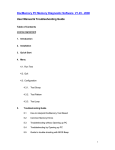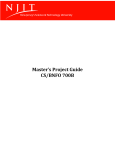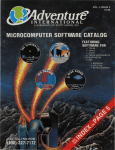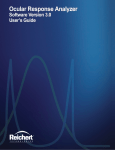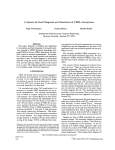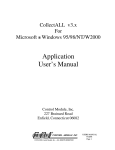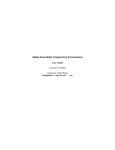Download OCML manual
Transcript
Operational Concept Modelling Language
Dave Lambert and Enrico Motta
i
Table of Contents
1
Introduction . . . . . . . . . . . . . . . . . . . . . . . . . . . . . . . . . . . . . 1
1.1
2
Installation . . . . . . . . . . . . . . . . . . . . . . . . . . . . . . . . . . . . . . 2
2.1
2.2
2.3
3
Provenance . . . . . . . . . . . . . . . . . . . . . . . . . . . . . . . . . . . . . . . . . . . . . . . . . . . . 1
Obtaining OCML . . . . . . . . . . . . . . . . . . . . . . . . . . . . . . . . . . . . . . . . . . . . . . 2
Setup . . . . . . . . . . . . . . . . . . . . . . . . . . . . . . . . . . . . . . . . . . . . . . . . . . . . . . . . . . 2
Library locations . . . . . . . . . . . . . . . . . . . . . . . . . . . . . . . . . . . . . . . . . . . . . . . 2
Domain Modelling in OCML . . . . . . . . . . . . . . . . . . 3
3.1
Overview . . . . . . . . . . . . . . . . . . . . . . . . . . . . . . . . . . . . . . . . . . . . . . . . . . . . . . 3
3.1.1 Functional terms . . . . . . . . . . . . . . . . . . . . . . . . . . . . . . . . . . . . . . . . . . 3
3.1.2 Control terms . . . . . . . . . . . . . . . . . . . . . . . . . . . . . . . . . . . . . . . . . . . . . 3
3.1.3 Logical expressions . . . . . . . . . . . . . . . . . . . . . . . . . . . . . . . . . . . . . . . . 3
3.2 Ontologies . . . . . . . . . . . . . . . . . . . . . . . . . . . . . . . . . . . . . . . . . . . . . . . . . . . . . 3
3.3 Classes . . . . . . . . . . . . . . . . . . . . . . . . . . . . . . . . . . . . . . . . . . . . . . . . . . . . . . . . . 5
3.4 Instances . . . . . . . . . . . . . . . . . . . . . . . . . . . . . . . . . . . . . . . . . . . . . . . . . . . . . . . 6
3.5 Relations . . . . . . . . . . . . . . . . . . . . . . . . . . . . . . . . . . . . . . . . . . . . . . . . . . . . . . 6
3.5.1 Relation specification options . . . . . . . . . . . . . . . . . . . . . . . . . . . . . . 7
3.5.2 Operationally-relevant relation options . . . . . . . . . . . . . . . . . . . . . 7
3.5.3 Summing up . . . . . . . . . . . . . . . . . . . . . . . . . . . . . . . . . . . . . . . . . . . . . . 9
3.6 Functions . . . . . . . . . . . . . . . . . . . . . . . . . . . . . . . . . . . . . . . . . . . . . . . . . . . . . . 9
3.7 Procedures . . . . . . . . . . . . . . . . . . . . . . . . . . . . . . . . . . . . . . . . . . . . . . . . . . . . 10
3.8 Namespaces . . . . . . . . . . . . . . . . . . . . . . . . . . . . . . . . . . . . . . . . . . . . . . . . . . . 10
3.9 Translation between representation languages . . . . . . . . . . . . . . . . . . 12
3.10 The ask-tell interface . . . . . . . . . . . . . . . . . . . . . . . . . . . . . . . . . . . . . . . . . 12
4
Rule-based reasoning . . . . . . . . . . . . . . . . . . . . . . . . . . 14
4.1
4.2
5
Modelling issues . . . . . . . . . . . . . . . . . . . . . . . . . . . . . . . 16
5.1
6
Backward-chaining rules. . . . . . . . . . . . . . . . . . . . . . . . . . . . . . . . . . . . . . . 14
Forward-chaining rules . . . . . . . . . . . . . . . . . . . . . . . . . . . . . . . . . . . . . . . . 14
Object-oriented and relation-oriented approaches to modelling
. . . . . . . . . . . . . . . . . . . . . . . . . . . . . . . . . . . . . . . . . . . . . . . . . . . . . . . . . . . . . . . 16
Functional View of OCML . . . . . . . . . . . . . . . . . . . . 17
6.1
6.2
6.3
Mapping . . . . . . . . . . . . . . . . . . . . . . . . . . . . . . . . . . . . . . . . . . . . . . . . . . . . . . 17
Instance mapping . . . . . . . . . . . . . . . . . . . . . . . . . . . . . . . . . . . . . . . . . . . . . 17
Relation mapping . . . . . . . . . . . . . . . . . . . . . . . . . . . . . . . . . . . . . . . . . . . . . 18
ii
7
Reference . . . . . . . . . . . . . . . . . . . . . . . . . . . . . . . . . . . . . . 20
7.1
Functional Term Constructors . . . . . . . . . . . . . . . . . . . . . . . . . . . . . . . . .
7.1.1 setofall . . . . . . . . . . . . . . . . . . . . . . . . . . . . . . . . . . . . . . . . . . . . . . . . . . .
7.1.2 findall . . . . . . . . . . . . . . . . . . . . . . . . . . . . . . . . . . . . . . . . . . . . . . . . . . . .
7.1.3 the . . . . . . . . . . . . . . . . . . . . . . . . . . . . . . . . . . . . . . . . . . . . . . . . . . . . . . .
7.1.4 in-environment . . . . . . . . . . . . . . . . . . . . . . . . . . . . . . . . . . . . . . . . . . .
7.1.5 quote . . . . . . . . . . . . . . . . . . . . . . . . . . . . . . . . . . . . . . . . . . . . . . . . . . . .
7.1.6 if . . . . . . . . . . . . . . . . . . . . . . . . . . . . . . . . . . . . . . . . . . . . . . . . . . . . . . . .
7.1.7 cond . . . . . . . . . . . . . . . . . . . . . . . . . . . . . . . . . . . . . . . . . . . . . . . . . . . . .
7.2 Control Term Constructors . . . . . . . . . . . . . . . . . . . . . . . . . . . . . . . . . . . .
7.2.1 in-environment . . . . . . . . . . . . . . . . . . . . . . . . . . . . . . . . . . . . . . . . . . .
7.2.2 if . . . . . . . . . . . . . . . . . . . . . . . . . . . . . . . . . . . . . . . . . . . . . . . . . . . . . . . .
7.2.3 cond . . . . . . . . . . . . . . . . . . . . . . . . . . . . . . . . . . . . . . . . . . . . . . . . . . . . .
7.2.4 loop. . . . . . . . . . . . . . . . . . . . . . . . . . . . . . . . . . . . . . . . . . . . . . . . . . . . . .
7.2.5 do . . . . . . . . . . . . . . . . . . . . . . . . . . . . . . . . . . . . . . . . . . . . . . . . . . . . . . .
7.2.6 repeat. . . . . . . . . . . . . . . . . . . . . . . . . . . . . . . . . . . . . . . . . . . . . . . . . . . .
7.2.7 return. . . . . . . . . . . . . . . . . . . . . . . . . . . . . . . . . . . . . . . . . . . . . . . . . . . .
7.3 Grammar . . . . . . . . . . . . . . . . . . . . . . . . . . . . . . . . . . . . . . . . . . . . . . . . . . . . .
7.4 Inheritance and Default Values . . . . . . . . . . . . . . . . . . . . . . . . . . . . . . . .
8
Interpreters and Proof System . . . . . . . . . . . . . . . 24
8.1
8.2
8.3
8.4
9
20
20
20
20
20
20
20
20
20
20
21
21
21
21
21
21
21
23
Functional term interpreter. . . . . . . . . . . . . . . . . . . . . . . . . . . . . . . . . . . .
Control term interpreter. . . . . . . . . . . . . . . . . . . . . . . . . . . . . . . . . . . . . . .
Proof system . . . . . . . . . . . . . . . . . . . . . . . . . . . . . . . . . . . . . . . . . . . . . . . . . .
Proof rules for non-basic goal expressions . . . . . . . . . . . . . . . . . . . . . .
24
24
24
25
Bibliography . . . . . . . . . . . . . . . . . . . . . . . . . . . . . . . . . . . 27
Function Index . . . . . . . . . . . . . . . . . . . . . . . . . . . . . . . . . . . . 28
Concept Index . . . . . . . . . . . . . . . . . . . . . . . . . . . . . . . . . . . . . 29
Chapter 1: Introduction
1
1 Introduction
1.1 Provenance
This manual is substantially based on chapter 4 and appendix 1 of [Reusable Components
for Knowledge Modelling], page 27 by Enrico Motta. Dave Lambert reformatted it as
Texinfo, reorganized the material to something more appropriate to a user manual, and
added the installation and namespace sections.
Chapter 2: Installation
2
2 Installation
OCML is implemented in Lisp, and currently runs under Lispworks and SBCL.
2.1 Obtaining OCML
You can obtain the development version of OCML using Git1 .
git clone http://kmi-forge.open.ac.uk/git/ocml.git
This should leave you with a directory called ‘ocml’.
2.2 Setup
OCML uses the ASDF system definition package. You can find out more about ASDF at
http://www.cliki.net/asdf. If you have ASDF installed, make sure the ‘ocml.asd’ file
is accessible from asdf:*central-registry*, and then load it:
CL-USER > (asdf:operate ’asdf:load-op :ocml)
or, if you’re using a Lisp which integrates ASDF with require, just do:
CL-USER> (require :ocml)
You then need to initialize OCML:
CL-USER> (ocml:initialize-ocml)
2.3 Library locations
OCML finds its libraries (the ontologies) via logical pathnames. The logical host ocml
holds the translations. Immediately after loading OCML, this will be set to include the
basic OCML library:
CL-USER> (logical-pathname-translations "ocml")
(("ocml:library;basic;**;*" "/home/djl/dev/ocml/library/basic/"))
Additional translations can be added, for instance in the IRS, the translations look like
this:
CL-USER> (logical-pathname-translations "ocml")
(("ocml:library;basic;**;*" "/home/djl/dev/ocml/documentation//library/basic/")
("ocml:library;**;*" "/home/djl/dev/irs/live/code/ocml/library/v5-0/**/*"))
Translations earlier in the list take precedence.
1
http://git.or.cz/
Chapter 3: Domain Modelling in OCML
3
3 Domain Modelling in OCML
3.1 Overview
OCML provides mechanisms for defining relations, functions, classes, instances, rules and
procedures.
OCML supports the specification of three types of constructs: functional and control
terms, and logical expressions.
3.1.1 Functional terms
A functional term - in short, a term - specifies an object in the current domain of investigation. A functional term can be a constant, a variable, a string, a function application or can
be constructed by means of a special term constructor. This can be one of the following: if,
cond, the, setofall, findall, quote and in-environment7 - see appendix 1 for a description of
the semantics of these terms. Variables are represented as Lisp symbols beginning with a
question mark, e.g. ?x is a variable. Strings are sequences of characters enclosed in double
quotes, e.g. "string". A function application is a term such as (fun {fun-term}*), where
fun is the name of a function and fun-term a functional term. Functions are defined by
means of the Lisp macro def-function, which is described in Section 3.6 [Functions], page 9.
Functional terms are evaluated by means of the OCML function interpreter, which is
described in detail in appendix 1.
3.1.2 Control terms
Modelling problem solving behaviour involves more than making statements and describing
entities in the world. Control terms are needed to specify actions and describe the order
in which these are executed. OCML supports the specification of sequential, iterative and
conditional control structures by means of a number of control term constructors, such as
repeat, loop, do, if, and cond8. A Lisp macro, def-procedure, makes it possible to label
parametrized control terms - i.e. to define procedures. Control terms are evaluated by
means of a control interpreter. This is described in appendix 1.
3.1.3 Logical expressions
OCML also provides the usual machinery for specifying logical expressions. The simplest
kind of logical expression is a relation expression, which has the form (rel {fun-term}*),
where rel is the name of a relation and fun-term is a functional term. More complex
expressions can be constructed by using the logical operators and, or, not, =>, <=> and
quantifiers - forall and exists. Operational semantics is provided for all operators and
quantifiers. Relations are defined by means of the Lisp macro def-relation.
3.2 Ontologies
OCML organises its knowledge models using ontologies. When an ontology is defined, say
‘O’, it is possible to specify which ontologies are included in ‘O’ and as a result ‘O’ will include
all the definitions from its parent ontologies. When conflicts are detected (e.g., the same
concept is defined in two different parent ontologies), a warning is issued. Primitives for
loading and selecting ontologies are also provided.
Chapter 3: Domain Modelling in OCML
4
By default all ontologies are built on top of the OCML base ontology. This comprises
twelve sub-ontologies which include the basic definitions required to reason about basic data
types (e.g. lists, numbers, sets and strings), the OCML system itself and the OCML frame
representation. Specifically, the following sub-ontologies are provided:
Meta
This ontology defines the concepts required to describe the OCML language.
It includes constructs such as ‘OCML expression’, ‘functional term’, ‘rule’, ‘relation’, ‘function’, ‘assertion’, etc. This ontology is particularly important to
construct reasoning components which can verify OCML models.
Functions
Defines the concepts associated with functions - e.g., it includes relations such
as domain, range, unary-function, binary-function, etc.
Relations
Defines the various notions associated with relations. These include the universe and the extension of a relation, the definition of reflexive and transitive
relations, partial and total orders, etc.
Sets
This ontology defines the notions associated with sets - e.g., ‘empty set’, ‘union’,
‘intersection’, ‘set partition’, ‘set cardinality’, etc.
Numbers
Defines the various concepts and operations required for reasoning about numbers and for performing calculations.
Lists
Defines the concepts and operations associated with lists. It includes classes
such as list and atom; functions such as first, rest and append; and relations
such as member.
Strings
Specifies the concepts and operations associated with strings - e.g., string,
string-append, etc.
Mapping
This ontology defines the concepts associated with the mapping mechanism described earlier. It includes only three definitions: relation maps-to and functions
meta-reference and domain-reference. The former takes a domain-level instance
and returns the associated task/method level instance. The latter performs the
inverse function.
Frames
Defines the concepts associated with the frame-based representation used in
OCML. It comprise (meta-) classes such as class and instance; functions such as
direct-instances and all-slot-values; relations such as has-one and has-at-most;
and procedures such as append-slot-value.
Inferences The purpose of this ontology is to provide a repository for defining functions
and relations supporting the specification of KADS-like inferences. So far only
a few such inferences have been added to this ontology to support different
types of selection and sorting.
Environment
This ontology provides a kind of ‘environmental support’ for the construction of
OCML models. It includes special operators like exec, which makes it possible
to invoke procedures from rules, and procedures such as output, which prints
out a message.
Chapter 3: Domain Modelling in OCML
5
Task-Method
This ontology provides the concepts required to model tasks and problem solving methods, i.e. to support the construction of task and problem solving
models.
This set of ontologies provides a rich modelling platform from which to build other ontologies and/or problem solving models. It is natural to compare the OCML and Ontolingua
base ontologies (Farquhar et al., 1996). There are two aspects which distinguish these two
sets of ontologies: their nature and their scope.
The first difference is related to the operational nature of OCML. The Ontolingua base
ontology is not concerned with operationality and therefore includes many non-operational
definitions. The OCML base ontology is concerned with providing support for the construction of operational models. As a result it attempts to minimize the number of non-executable
specifications. A typical approach is to weaken a non-operational definition to make it executable. For instance let’s consider the function universe. In the Ontolingua base ontology
the universe of a relation is defined as the set of all objects for which the relation is true.
Of course this is not an operational definition. However, we can provide a weaker version
of universe, called known-universe, which returns the set of all entities which are part of
a tuple satisfying the relation in question. This function can be either defined separately
from universe or attached to it to provide an operational definition.
The second difference concerns the scope of the two base ontologies. Both the Ontolingua
and OCML base ontologies provide a rich set of definitions for domain modelling. In order to
comply with the requirements imposed by the TMDA framework, the OCML base ontology
provides support also for specifying tasks and problem solving methods.
3.3 Classes
OCML also supports the specification of classes and instances and the inheritance of slots
and values through isa hierarchies.
Classes are defined by means of a Lisp macro, def-class, which takes as arguments the
name of the class, a list (possibly empty) of superclasses, optional documentation, and a list
of slot specifications, as illustrated by the definitions in the next box. These show a number
of classes taken from the domain model for the Sisyphus-I office allocation problem (Linster,
1994; Chapter 9). This problem consists of allocating members of the YQT laboratory to
the appropriate offices, according to a number of constraints.
(def-class YQT-member ()
((has-project :type project)
(smoker :type boolean :cardinality 1)
(hacker :type boolean :cardinality 1)
(works-with :type YQT-member)
(belongs-to-group :type research-group :value yqt)))
(def-class researcher (YQT-member))
(def-class secretary (YQT-member))
(def-class manager (YQT-member))
OCML provides support for the usual slot specification machinery which is found in
frame-based languages. Specifically, it provides the following slot options.
Chapter 3: Domain Modelling in OCML
value
default-value
type
max-cardinality
min-cardinality
cardinality
documentation
inheritance
6
A value which is inherited by all instances
of a class.
A value which is inherited by all instances
of a class, unless overridden by other values.
The value of this option should be a class,
say C. This option specifies that all values
of the associated slot should be instances of
C. It is also possible to specify that a slot
value must belong to one or more classes,
say C1,...., Cn, by using the notation (or
C1 C2..Cn).
The maximum numbers of slot values allowed for a slot.
The minimum numbers of slot values required for a slot.
The numbers of slot values required for a
slot. This option subsumes both :mincardinality and :max-cardinality.
The value of this option is a string providing documentation for a slot.
The inheritance mechanism used for dealing with default values. If :merge is used,
then all default values inherited from different ancestors are collected. If :supersede
is used, then default values inherited from
more specific ancestors override those inherited from more generic ones.
3.4 Instances
Instances are simply members of a class. An instance is defined by means of def-instance,
which takes as arguments the name of the instance, the parent of the instance (i.e. the most
specific class the instance belongs to), optional documentation and a number of slot-value
pairs. An example of instance definition, taken from the Sisyphus-I domain model, is shown
in the box below.
(def-instance harry_c researcher
((has-project babylon)
(smoker no)
(hacker yes)
(works-with jurgen_l thomas_d)))
In particular the above definition shows that a slot can have multiple values. In this
case harry_c works both with jurgen_l and thomas_d.
3.5 Relations
Relations allow the OCML user to define labelled n-ary relationships between OCML entities. Relations are defined by means of a Lisp macro, def-relation, which takes as
arguments the name of a relation, its argument schema, optional documentation and a
Chapter 3: Domain Modelling in OCML
7
number of relation options. An argument schema is a list (possibly empty) of variables.
Relation options play two roles, one related to the formal semantics of a relation, the other
to the operational nature of OCML. These roles are discussed in the next two sections.
3.5.1 Relation specification options
From a formal semantics point of view the purpose of a relation option is to help characterize
the extension of a relation. The table below shows the relation options which can be
used to provide formal relation specifications and, for each option, informally describes its
semantics. A formal semantics to these options can be given in terms of the homonymous
Ontolingua constructs.
Relation option
:iff-def
:sufficient
:constraint
:def
:axiom-def
Role in specification
Specifies both sufficient and necessary conditions for the relation to
hold for a given set of arguments.
Specifies a sufficient condition for the relation to hold for a given set
of arguments.
Specifies an expression which follows from the definition of the relation
and must be true for each instance of the relation.
This is for compatibility with Ontolingua: it specifies a constraint
which is also meant to provide a partial definition of a relation.
A statement which mentions the relation to which it is associated.
It provides a mechanism to associate theory axioms with specific
relations.
3.5.2 Operationally-relevant relation options
Relation options also play an operational role. Specifically, some relation options support
constraint checking over relation instances while others provide proof mechanisms which
can be used to find out whether or not a relation holds for some arguments. The table
below lists the relation options which are meaningful from an operational point of view and
informally describes their relevance to constraint checking and theorem proving.
Relation option
:sufficient
:prove-by
:lisp-fun
:iff-def
:constraint
:def
Supports constraint checking
No
No
No
Yes
Yes
Yes
Provides proof mechanism
Yes
Yes
Yes
Yes
No
No
As shown in the table, constraint checking is supported by the following keywords:
:constraint, :def and :iff-def. While these have different model-theoretic semantics,
from a constraint checking point of view they are equivalent. They all specify an expression
which has to be satisfied by each known instance of the relevant relation.
The relation options :iff-def, :sufficient, :prove-by and :lisp-fun provide mechanisms for verifying whether or not a relation holds for some arguments. The first two—
:iff-def and :sufficient—also play a specification role. The others—:prove-by and
:lisp-fun—only play an operational role.
Chapter 3: Domain Modelling in OCML
8
Both :iff-def and :sufficient indicate logical expressions which can be used to prove
whether some tuple is an instance of a relation. From a theorem proving point of view there
is an important difference between them. Let’s suppose we are trying to prove that a tuple,
say T, satisfies a relation, say R. If a :sufficient condition is tried and failed, the OCML
proof system will then search for alternative ways of proving that T satisfies R. If an :iffdef condition is tried and failed, then no alternative proof mechanism will be attempted.
The relation options :prove-by and :lisp-fun are meant to support rapid prototyping
and early validation by providing efficient mechanisms for checking whether a tuple satisfies
a relation. The difference between :prove-by and :lisp-fun has to do with the expressions
which are used as values to the two options: :prove-by points to a logical expression,
:lisp-fun to a non-logical one (specifically a Lisp expression).
The box below provides an example of how the various types of relation options can
be used concurrently to specify a relation and to support constraint checking and efficient
proofs. The relation has-value, shown below, associates a design parameter to its value
in a design model. The definition specifies that ?v is the value of a parameter, ?p, in a
design model, ?dm, if and only if the pair (?p . ?v) is an element of ?dm. In addition, it
also specifies the constraint that the value of a parameter has to be a member of its value
range, if this has been specified. Finally, the definition includes a :prove-by option whose
value is an expression which can be used for verifying whether the relation is satisfied for a
triple, (?p ?v ?dm). This expression provides an efficient proof method (by weakening the
:iff-def statement which formally defines relation has-value) but does not contribute to the
specification.
(def-relation HAS-VALUE (?p ?v ?dm)
"Parameters have values w.r.t a particular design model"
:iff-def (and (parameter ?p)
(design-model ?dm)
(element-of (?p . ?v) ?dm))
:constraint (or (and (exists ?vr
(has-value-range ?p ?vr))
(element-of ?v ?vr))
(not (exists ?vr
(has-value-range ?p ?vr))))
:prove-by (element-of (?p . ?v) ?dm))
A meta-option for non-operational specifications
As shown above, OCML provides a number of relation options, which play both a specification and an operational role. However, in some cases we might want to use a keyword
only for specification and not operationally, for instance when we know that the value of the
keyword in question is a non-operational expression. To cater for these situations, OCML
provides a special meta-keyword, :no-op, which can be used to indicate that the enclosed
relation option only plays a specification role. An example of its use is shown by the definition of relation range, which is shown below. In the example the keyword :no-op is used
to indicate that the :iff-def specification of the relation is not operational - in particular
it is not normally feasible to test the range of a function on all its possible inputs!
(def-relation RANGE (?f-r ?relation)
"The range of a function or a binary relation is a relation which is
true for any possible output of the function or second argument of
the binary relation"
:no-op (:iff-def (or
(and (function ?f-r)
Chapter 3: Domain Modelling in OCML
9
(forall (?args ?result)
(=> (= (apply ?f-r ?args) ?result)
(holds ?relation ?result))))
(and (binary-relation ?f-r)
(forall (?x ?y)
(=> (holds ?f-r ?x ?y))
(holds ?relation ?y))))))
In the above definition it is worth highlighting the use of the special meta-relation holds.
An expression such as (holds <r> <arg1>....<argn>) is satisfied if and only if the expression (<r> <arg1>....<argn>) is satisfied. Thus holds has variable arity: it can take one
or more arguments. In particular the number of additional arguments in a holds statement
reflects the arity of the relation passed as first argument. The relation holds has a ‘special
status’ because it is the only relation with variable arity supported by OCML.
3.5.3 Summing up
The set of relation options discussed here aims to provide a flexible and versatile range
of modelling constructs supporting various styles of modelling. While the emphasis is on
operational modelling, OCML also supports formal specification. Moreover, it provides
facilities for integrating a specification with efficient proof mechanisms.
3.6 Functions
A function defines a mapping between a list of input arguments and its output argument.
Formally functions can be characterized as a special class of relations, as in KIF (Genesereth
and Fikes, 1992). However, in operational terms there is a significant difference between a
function and a relation: functions are applied to ground terms to generate function values;
relation expressions can be asserted or queried. Thus, in accordance with the operational
nature of OCML, functions are distinguished from relations.
Functions are defined by means of a Lisp macro, def-function. This takes as argument the
name of a function, its argument list, an optional variable indicating the output argument
(as in Ontolingua this is preceded by an arrow, ->), optional documentation and zero or
more function specification options. These are :def, :constraint, :body and :lisp-fun.
The option :constraint provides a way to constrain the domain (i.e. the set of possible
inputs) of a function. It specifies a logical expression which must be satisfied by the input
arguments of the function. The :def option indicates a logical expression which ‘defines’ the
function. This expression should be predicated over both (some) input arguments and the
output variable. Operationally, the expression denoted by the :constraint option provides
a mechanism for testing the feasibility of applying a function to a set of arguments. The
expression denoted by :def provides a mechanism for verifying that the output produced by
a function application is consistent with the formal definition of the function.
Finally, the options :body and :lisp-fun provide effective mechanisms for computing
the value of a function. The former specify a functional term which is evaluated in an environment in which the variables in the function schema are bound to the actual arguments.
The latter makes it possible to evaluate an OCML function by means of a procedural attachment, expressed as a Lisp function. The arity of this Lisp function should be the same
as that of the associated OCML function.
(def-function filter (?l ?rel) -> ?sub-l
"Returns all the elements in ?l which satisfy ?rel"
Chapter 3: Domain Modelling in OCML
10
:def (and (unary-relation ?rel)
(list ?l))
(list ?sub-l)
(=> (and (member ?x ?sub-l)
(holds ?rel ?x))
(member ?x ?l)))
:body (if (null ?l)
?l
(if (holds ?rel (first ?l))
(cons (first ?l)
(filter (rest ?l) ?rel))
(filter (rest ?l) ?rel))))
The above definition shows an example of the use of def-function. The OCML function
filter takes as arguments a list, ?l, and a unary relation, ?rel, and returns the elements of ?l
which satisfy ?rel. As illustrated by the definition, the :def option provides a declarative
way of specifying a function; the option :body an effective way of computing its value, for
a given set of input arguments.
3.7 Procedures
Procedures define actions or sequences of actions which cannot be characterized as functions between input and output arguments. For example, the procedure below defines the
sequence of actions needed to set the value of a slot. These include a unassert statement,
which removes any existing value from the slot, and a tell statement, which adds the new
value. Both tell and unassert are procedures. The former takes a ground logical expression
and adds it to the current model. The latter takes a relation expression and removes from
the current model all assertions which match it. Note that in accordance with the uniform
view of a knowledge model, slot changes are carried out by means of generic assertion and
deletion operations (i.e. in terms of tell and unassert).
(def-procedure SET-SLOT-VALUE (?i ?s ?v)
:constraint (and (instance-of ?i ?c)
(slot-of ?s ?c))
:body (do
(unassert (list-of ?s ?i ?any))
(tell (list-of ?s ?i ?v))))
3.8 Namespaces
OCML uses Lisp symbols to name things. This is convenient, but awkward when dealing
with ontologies on a global scale. OCML now supports a convenient interface for namespaces
which is very similar to the XML namespaces scheme. Three things are involved in this
extension:
1. OCML ontologies must indicate the URI which identifies them.
2. Namespaces prefixes are registered with OCML before use.
3. Namespaced symbols are prefixed with #_.
Ontology definitions should include a :namespace-uri initialization argument, which is
a string holding the URI identifying the ontology. If you do not supply a namespace URI,
OCML will assign one based on the ontology’s name.
(def-ontology colours
:author "dave"
Chapter 3: Domain Modelling in OCML
11
:namespace-uri "http://www.kmi.open.ac.uk/colours#"
:files ())
(def-ontology fruits
:author "dave"
:namespace-uri "http://www.kmi.open.ac.uk/fruits#"
:files ())
Next, we tell OCML which prefixes we intend to use:
(register-namespace "colours" ’colours)
(register-namespace "fruit" ’fruits)
We can then use these prefixes in ontologies, using a Lisp reader macro, #_. Classes,
instances, and relations can all be named in this way. Viz:
(in-ontology colours)
(def-class #_colour ())
(def-class #_blue (#_colour)
(def-class #_red (#_colour)
(def-class #_orange (#_colour)
(in-ontology fruit)
(def-class #_fruit ())
(def-class #_orange (#_fruit)
(#_colors:has-colour #_colours:orange))
Here, #_colours:orange and #_fruit:orange are different symbols, from different
namespaces and ontologies, used together in one ontology.
When Lisp reads a namespaced symbol, it converts it to a symbol by concatenating
the value of the referenced ontology’s namespace-uri slot with the symbol. Thus, #_
fruit:orange becomes OCML::|http://www.kmi.open.ac.uk/fruits#orange|. It is important to remember that the #_ syntax is merely a shorthand for the long, quoted Lisp
symbol. If you so wish, you can enter the long form directly, as a normal Lisp symbol.
Given this, namespaced variables interoperate fully with non-namespaced ones. The prefixes themselves are discarded after they have been read in by the Lisp reader. Namespaced
symbols are case sensitive: #_foo is distinct from #_Foo.
Further examples from a Lisp listener session:
OCML> (in-ontology fruits)
#<OCML-ONTOLOGY FRUITS>
OCML> ’#_colours:orange
OCML::|http://www.kmi.open.ac.uk/fruits#orange|
OCML> ’#_orange
OCML::|http://www.kmi.open.ac.uk/fruits#orange|
OCML> (register-namespace "colors" ’colours)
#<OCML-ONTOLOGY COLOURS>
OCML> (in-ontology colours)
#<OCML-ONTOLOGY COLOURS>
OCML> ’#_orange
OCML::|http://www.kmi.open.ac.uk/colours#orange|
OCML> (eq ’#_colours:orange ’#_colours:orange)
T
Chapter 3: Domain Modelling in OCML
12
OCML> (eq ’#_colors:orange ’#_colours:orange)
T
OCML> (eq ’#_colors:orange ’ocml::|http://www.kmi.open.ac.uk/colours#orange|)
T
OCML> (eq ’#_colours:orange ’#_colours:Orange)
NIL
The notation #_ is modelled after the WSML syntax for IRIs, _"http://www.deri.org/foo".
3.9 Translation between representation languages
While OCML is an excellent language for knowledge modelling, poor taste is widespread and
we must often translate to and from other representations. For this, we use the translate
generic function. translate takes 4 required arguments: keywords indicating source and
destination lanuages, an object in the source language, and a stream to write the output
to.
(translate :ocml :rdf ’colours *standard-output*)
XXX At present, not all translations are available through this interface, and the methods
of returning the result are idiosyncratic.
3.10 The ask-tell interface
In particular, in the case of OCML, this generic idea of providing a uniform level of description to a hybrid formalism has been instantiated by providing a Tell-Ask interface
(Levesque, 1984), which use logical expressions (i.e. a relation-oriented view) when modifying or querying an OCML model, independently of whether the query in question concerns
a class, a slot, or a ‘ordinary’ relation. The key to this integrated view is the fact that
classes and slots are themselves relations; classes are unary relations and slots are binary
ones. In addition to supporting a generic Tell-Ask interface, this property makes it possible to provide ‘rich’ specifications of classes and slots. In particular, because these are
relations, it is possible to characterize them by means of the relation options discussed in
section Section 3.5 [Relations], page 6. For instance, the definition below specifies the class
of empty sets in terms of an :iff-def relation option.
(def-class EMPTY-SET (set) ?set
:iff-def (not (exists ?x (element-of ?x ?set))))
The generic Tell-Ask interface Tell: a generic assertion-making primitive
OCML provides a generic assertion-making primitive, tell, which provides a uniform
mechanism for asserting facts, independently of whether these refer to slot-filling assertions,
new class instances, or simply relation instances. For example I can use tell to add a new
value to the list of projects carried out by harry c as follows.
? (tell (has-project harry_c mlt))
(HAS-PROJECT HARRY_C MLT)
Analogously I can add a new instance of class researcher simply by stating:
? (tell (researcher mickey_m))
(RESEARCHER MICKEY_M)
The relation-centred view makes it possible to examine the contents of an OCML model
simply by asking whether a logical statement is satisfied. The OCML proof system will
then carry out the relevant inference and retrieval operations, depending on whether the
relation being queried is a slot, a class, or an ‘ordinary’ relation. The process is however
Chapter 3: Domain Modelling in OCML
13
transparent to the user. For instance, I can find out about the projects in which harry c
is involved - after the assertion shown above these are now babylon and mlt - by using the
Lisp macro ask to pose the query (has-project harry c ?c). The resulting interaction with
the OCML proof system is shown below.
? (ask (has-project harry_c ?c))
Solution: ((HAS-PROJECT HARRY_C BABYLON))
More solutions? (y or n) y
Solution: ((HAS-PROJECT HARRY_C MLT))
More solutions? (y or n) y
No more solutions
This uniform, relation-centred view over OCML models also provides a way to index
inferences. For instance, when answering the above query, the OCML proof system will
first retrieve and order all inference mechanisms applicable to a query of type has-project
- e.g., these might include assertions of type has-project, relation options associated with
has-project and the relevant backward rules13 - and will then try these in sequence, to
generate one or more solutions to the query.
Chapter 4: Rule-based reasoning
14
4 Rule-based reasoning
OCML can reason with backward and forward chaining rules.
4.1 Backward-chaining rules
A backward rule consists of a number of backward clauses, each of which is defined according
to the following syntax:
backward-clause ::= (relation-expression {if {logical-expression}+})
Each backward clause specifies a different goal-subgoal decomposition. When carrying
out a proof by means of a backward rule the OCML interpreter will try to prove the relevant
goal by firing the clauses in the order in which these are listed in the rule definition. As
in Prolog, depth-first search with chronological backtracking is used to control the proof
process.
Both semantically and operationally a backward chaining rule is the same as a :sufficient
relation option: they both provide an expression which is sufficient to verify that a tuple
holds for a relation. Thus, one might wonder whether rules are needed at all. In practice
the advantage of including backward rules in the language is that these provide a modular mechanism for refining existing (possibly generic) relation specifications, for instance
in cases where application-specific knowledge is needed to complete the specification of a
relation. To clarify this point let’s consider an example taken from the KMI office allocation
problem (see chapter 9 for an extensive analysis of this application).
The relation has-value-range is defined in the parametric design task ontology to characterize the set of possible values which can be assigned to a design parameter - see chapter
6. When building an application model the generic has-value-range specification is usually
refined, so that the space of possible values that can be assigned to a particular parameter
is precisely defined. A modular way to achieve this is to refine the definition of the relation
by means of the appropriate backward chaining rules. The rules shown below fulfil this
purpose for two of the classes of parameters present in the KMI office allocation domain:
professors and secretaries. In this example the former can only go into a double room; the
latter into a large room next to the entrance.
(def-rule has-value-range-1
((has-value-range-gen ?m ?l)
if
(professor (domain-reference ?m))
(= ?l (setofall ?r (double-a-type-room ?r usable yes)))))
(def-rule has-value-range-2
((has-value-range-gen ?m ?l)
if
(secretary (domain-reference ?m))
(= ?l (setofall ?r
(and (room ?r size ?n usable yes)
(> ?n 1)
(close-to ?r kmi-entrance))))))
4.2 Forward-chaining rules
OCML also allows the user to define forward rules. A forward rule comprises zero or more
antecedents and one or more consequents. Antecedents are restricted to relation expressions,
Chapter 4: Rule-based reasoning
15
while any logical expression can be a consequent. When a forward rule is executed, OCML
treats each consequent as a goal to be proven and attempts to prove them, until one fails.
This mechanism makes it possible to integrate data-driven and goal-driven reasoning and
to specify arbitrarily complex right hand sides.
A special operator, exec, is provided to allow OCML users to introduce control (and
therefore functional) terms in the right hand side of a rule. In particular, two useful procedures are tell, to assert new facts, and output, to produce output. A simple example
showing how to use these in a forward chaining rule is given below.
(def-rule has-project-cond
(has-project ?x ?y)
then
(exec (tell (project-covered-by ?y ?x)))
(exec (output "has-project-cond rule deduced (project-covered-by ~S ~S)~%" ?y ?x)))
(enable-fc-watcher-mode)
(def-instance larry-e researcher
((has-project tigris)
(smoker no)
(hacker yes)
(works-with harry_d)))
This produces the output ‘has-project-cond rule deduced (project-covered-by
TIGRIS LARRY-E)’.
While forward rules can be useful in a number of situations when building application
models (e.g. to define watchers, which are triggered whenever some situation arises in a
knowledge base), they are not essential to the model building process. The reason for this
is that knowledge-level modelling is mainly about constructing definitions, while forwardchaining rules are about behaviour. Thus they can be used in place of procedures to describe
behaviour but they cannot replace constructs for relation or function specification.
run-fc-rules
run
[Function]
[Function]
Explicitly run forward-chaining rules in the current ontology.
enable-fc-watcher-mode &optional packets
disable-fc-watcher-mode
[Function]
[Function]
Enable and disable the automatic triggering of forward chaining rules.
trace-fc
untrace-fc
Turn on and off the tracing of forward chaining rules.
[Function]
[Function]
Chapter 5: Modelling issues
16
5 Modelling issues
5.1 Object-oriented and relation-oriented approaches to
modelling
When describing classes and instances I made use of standard object-oriented terminology
and talked about slots having values and instances belonging to classes. This object-centred
approach is in a sense orthogonal to the relation-centred one which I used when discussing
relations and logical expressions. The former focuses on the entities populating a model
and then associates properties to them; the latter centres on the type of relations which
characterize a domain and then uses these to make statements about the world. These
two approaches to modelling/representation have complementary strengths and weaknesses
and for this reason they are often combined in knowledge representation and modelling
languages, to provide hybrid formalisms (Fikes and Kehler, 1985; Yen et al., 1988).
In the context of a knowledge modelling language (rather than a knowledge representation one) the main advantage gained from combining multiple paradigms is one of flexibility. Both object-oriented and relation-oriented approaches provide conceptual frameworks
which make it possible to impose a view over some domain. The choice between one or
the other can be made for ideological or pragmatic reasons - e.g. whether the target delivery environment is a rule-based shell or an object-oriented programming environment.
In the specific context of an operational modelling language, such as OCML, another benefit, which is gained by providing support for both object-oriented and relation-oriented
modelling, is that these approaches are naturally associated with particular types of inferences. Object-orientation provides the structure for inheritance and automatic classification;
relation-orientation is normally associated with constraint-based and rule-based reasoning.
While the integration of multiple paradigms provides the aforementioned benefits, when
describing or interacting with a knowledge model, it is useful to abstract from the various
modelling paradigms and inference mechanisms integrated in the model and characterize it
at a uniform level of description. Specifically, in accordance with a view of knowledge as a
competence-like notion (Newell, 1982), it is useful to decouple the level at which we describe
what an agent knows from the level at which we describe how the agent organizes and infers
knowledge. Such an approach is used - for instance - in the Cyc system (Lenat and Guha,
1990), which integrates multiple knowledge representation techniques (the heuristic level),
but provides a uniform interface to the Cyc knowledge base (the epistemological level). A
similar approach is also followed by Levesque (1984), which describes a logic-based query
language which can be used to communicate with a knowledge base at a functional level,
independently from the data and inference structures present in the knowledge base.
Chapter 6: Functional View of OCML
17
6 Functional View of OCML
A functional view of a knowledge representation system focuses on the services the system
provides to the user (Levesque, 1984; Brachman et al., 1985). Basically, there are three
kinds of services provided by OCML: i) operations for extending/modifying a model; ii)
interpreters for functional and control terms; and iii) a proof system for answering queries
about a model. Extensive details on the model extension/modification facilities provided by
OCML were given in earlier sections. The interpreters and the proof system are described
in detail in appendix 1.
6.1 Mapping
The constructs presented so far provide extensive support for domain modelling. In order to
fully support the TMDA framework additional constructs are needed, for specifying tasks
and methods and for mapping entities at the task/method level to entities at the domain
level. As already said, the conceptual vocabulary required to model tasks and methods
is not hardwired in the language but is defined as a specialized ontology. This will be
presented in the next chapter; in the next sections I will discuss the two kinds of mapping
constructs supported by OCML: relation mapping and instance mapping.
6.2 Instance mapping
Figure 3.8 XXX illustrated a simple example in which a class of concepts at the task/method
level (parameter) is mapped to a class of concepts at the domain level (employee). This
is a very common situation when developing systems through reuse: a problem solving,
domain-independent model imposes a particular view over a set of domain concepts (Fensel
and Straatman, 1996).
A simple case is one in which a domain view is constructed by direct association of task
level concepts to domain level concepts. For instance, a parametric design view over the
Sisyphus-I domain can be imposed simply by creating parameter instances and associating
them to YQT members. Thus, the set of parameters and the set of YQT members are
associated but kept distinct. This solution is appealing for two reasons: it supports reuse
of modular components and does not confuse the two different types of concepts; parameters and YQT members maintain different sets of properties and different semantics, thus
avoiding a situation in which a design parameter has a wife and a YQT member has a value
range.
Instance mapping is supported in OCML by means of the Lisp
mapping. This takes the names of two classes as arguments and
of the first class to a purpose-built instance of the second class.
maps-to is used to associate the task level instance to the domain
macro def-upward-classassociates each instance
By default the relation
level one.
In the Sisyphus-I application model we should then state:
(def-upward-class-mapping yqt-member yqt-parameter)
The above form iterates over each instance of class yqt-member, say I, creating a new
instance of class yqt-parameter, say Meta-I, and associating this to I, i.e., asserting (mapsto Meta-I I). Hence, if we now ask for the mapping between parameters and YQT members
we get the following results.
Chapter 6: Functional View of OCML
18
? (ask (maps-to ?z ?x)t)
Solution:
Solution:
Solution:
Solution:
Solution:
Solution:
Solution:
Solution:
Solution:
Solution:
Solution:
Solution:
Solution:
Solution:
Solution:
((MAPS-TO
((MAPS-TO
((MAPS-TO
((MAPS-TO
((MAPS-TO
((MAPS-TO
((MAPS-TO
((MAPS-TO
((MAPS-TO
((MAPS-TO
((MAPS-TO
((MAPS-TO
((MAPS-TO
((MAPS-TO
((MAPS-TO
YQT-PARAMETER-EVA_I EVA_I))
YQT-PARAMETER-MONIKA_X MONIKA_X))
YQT-PARAMETER-ULRIKE_U ULRIKE_U))
YQT-PARAMETER-UWE_T UWE_T))
YQT-PARAMETER-JOACHIM_I JOACHIM_I))
YQT-PARAMETER-HANS_W HANS_W))
YQT-PARAMETER-MICHAEL_T MICHAEL_T))
YQT-PARAMETER-ANGY_W ANGY_W))
YQT-PARAMETER-JURGEN_L JURGEN_L))
YQT-PARAMETER-KATHARINA_N KATHARINA_N))
YQT-PARAMETER-THOMAS_D THOMAS_D))
YQT-PARAMETER-HARRY_C HARRY_C))
YQT-PARAMETER-ANDY_L ANDY_L))
YQT-PARAMETER-MARC_M MARC_M))
YQT-PARAMETER-WERNER_L WERNER_L))
The advantage of this solution is that parameters and YQT members maintain their
separate identities, as shown in the next box.
? (describe-instance ’YQT-PARAMETER-WERNER_L)
Instance YQT-PARAMETER-WERNER_L of class YQT-PARAMETER
HAS-VALUE-RANGE: (C5-123 C5-122 C5-121 C5-120 C5-119 C5-117 C5-116 C5-113 C5-114 C5-115)
? (describe-instance ’WERNER_L)
Instance WERNER_L of class RESEARCHER
HAS-PROJECT: RESPECT
SMOKER: NO
HACKER: YES
WORKS-WITH: ANGY_W, MARC_M
GROUP: YQT
Formally, a mapping can be characterized as an association between an object, say o, and
its meta-object, m-o, so that the entity denoted by the entity denoted by m-o is the same
as the entity denoted by o (Genesereth and Nilsson, 1988). This notion can be formalized
in OCML by means of the following definition.
(def-relation maps-to (?x ?y)
"This relation allows the user to specify an association between
an object at the task layer and one at the domain layer.
Formally ?y denotes the object denoted by the object denoted by ?x"
:no-op (:iff-def (= ?y (denotation ?x))))
6.3 Relation mapping
Instance mapping works only in those cases in which imposing a view over a domain can be
reduced to creating task-level ‘mirror images’ for a finite number of domain-level objects. A
more general scenario is one in which there is some relation defined at the task/method level
which needs to be reflected to the domain level in a dynamic fashion. A well known example
is that in which domain concepts or statements are viewed as hypotheses at the problem
Chapter 6: Functional View of OCML
19
solving level. This association is typically dynamic, given that hypotheses are considered
as such only for a particular time-slice of the problem solving process. These situations can
be modelled in OCML by means of relation mappings.
A relation mapping provides a mechanism to associate rules and procedures to a relation,
say R, so that when a query of type R is posed, or assertions of type R are made at the
task/method level, these events can be reflected to the domain level. The purpose of these
reflection actions is to ensure that the consistency between domain and task/method levels
is maintained.
An example of an upward relation mapping is illustrated by the definition below, which
is taken from an application model developed for the Sisyphus-I problem. The mapping is
an upward one, in the sense that it is used to lift (van Harmelen and Balder, 1992) the office
allocation statements existing at the domain level to the problem solving level. Specifically,
the goal of this mapping is to associate the relation current-design-model, which is used
by the parametric design problem solver to indicate the design model associated with the
current design state, to the set of in-room assertions present in the current snapshot of the
domain knowledge base. The relation maps-to is used to retrieve the parameter associated
with each particular YQT member.
(def-relation-mapping current-design-model :up
((current-design-model ?dm)
if
(= ?dm (setofall (?p . ?v)
(and (in-room ?x ?v)
(maps-to ?p ?x))))))
An upward relation mapping ensures that when a task/method level relation is needed
the relevant information is obtained from the domain level. Of course, problem solving is
also about inferring knowledge and retracting previously held assertions. Hence, OCML also
supports downward relation mappings. These divide into two categories, :add and :remove.
The former specifies a procedure which is activated when a new relation instance is asserted.
The latter specifies a procedure which is activated when a relation instance is removed. In
the case of relation current-design-model relation mappings are needed to ensure that when
the design model considered by the problem solver is modified, the relevant changes are
reflected onto the domain model - see definition below.
(def-relation-mapping current-design-model (:down :add)
(lambda (?x)
(do
(unassert (in-room ?any-m ?any-r))
(loop for ?pair in ?x
do
(if (maps-to (first ?pair) ?z)
(tell (in-room ?z (rest ?pair))))))))
Finally, the definition below shows the :remove downward mapping associated with relation current-design-model: it simply removes the domain level assertions associated with
the design model which is passed as argument to the relation instance being retracted.
(def-relation-mapping current-design-model (:down :remove)
(lambda (?x)
(loop for ?pair in ?x
do
(if (maps-to (first ?pair) ?z)
(unassert (in-room ?z (rest ?pair)))))))
Chapter 7: Reference
20
7 Reference
7.1 Functional Term Constructors
7.1.1 setofall
setofall finds all solutions (i.e. environments) to basic-log-expression and then returns
the list obtained by instantiating template in all the returned environments, ensuring that
the list contains no duplicates. If no solutions are found then the empty list is returned.
7.1.2 findall
findall is the same as setofall except that it does not remove duplicate solutions.
7.1.3 the
the finds one solution (i.e. environment) to basic-log-expression and then returns the list
obtained by instantiating template in the returned environment. If no solutions are found
then the constant :nothing is returned.
7.1.4 in-environment
The primitive in-environment takes a list, possibly empty, of pairs ((var1 . term1)...) and
a body, and returns the result of evaluating this in an environment in which each vari is
bound to termi.
7.1.5 quote
The value of an expression such as (quote term) is term.
7.1.6 if
The first action which is carried out when evaluating an if-term is to check whether logexpression is satisfied. If this is the case, then then-term is evaluated in the environment
which satisfies log-expression. If log-expression cannot be satisfied in the current model,
then there are two possibilities. If else-term is specified, then this is evaluated, and the value
obtained is returned as the value of the if-term. If else-term is not present and log-expression
cannot be proved, then the constant :nothing is returned.
7.1.7 cond
The interpreter iterates through each clause of a cond-term, until it finds one whose logexpression is satisfied. If none is found, then :nothing is returned. Otherwise, let’s assume
cond-clausei. is the first clause whose log-expression is satisfied. In this case the value of
the cond-term is obtained by evaluating the term associated with cond-clausei.
7.2 Control Term Constructors
7.2.1 in-environment
The primitive in-environment takes a list, possibly empty, of pairs ((var1 . term1)...) and
a control-body, and returns the result of evaluating this in an environment in which each
vari is bound to termi.
Chapter 7: Reference
21
7.2.2 if
The first action which is carried out when evaluating an if-control-term is to check whether
log-expression is satisfied. If this is the case, then then-control-term is evaluated in the
environment which satisfies log-expression. If log-expression cannot be satisfied in the current model, then there are two possibilities. If else-control-term is specified, then this is
evaluated, and the value obtained is returned as the value of the if-control-term. If elsecontrol-term is not present and log-expression cannot be proved, then the constant :nothing
is returned.
7.2.3 cond
The interpreter iterates through each clause of a cond-control-term, until it finds one whose
log-expression is satisfied. If none is found, then :nothing is returned. Otherwise, let’s
assume cond-clausei. is the first clause whose log-expression is satisfied. In this case the
value of the cond-control-term is obtained by evaluating the control-term associated with
cond-clausei.
7.2.4 loop
The control construct loop provides a simple mechanism for iterating over lists. It first
evaluates a term, which should return a list, say L. Then it iterates over each element of L,
say I, and evaluates control-term in an environment in which variable is bound to I.
7.2.5 do
The control construct do is a simple sequencing primitive. The control terms in its body
are evaluated sequentially, once only.
7.2.6 repeat
The control term constructor repeat repeats the control term(s) specified in its body until
the end test is satisfied, if the test has the form ‘until test’. Otherwise, if the test has
the form ‘while test’, then repeat-actions stops as soon as the test fails. If the end test is
specified after the control terms, then the control terms are carried out at least once - i.e.
the end test is verified at the end of each cycle. If the end test is specified before the control
terms, then the test is verified at the beginning of each cycle. If no test is provided, then
all control expression in the body of a repeat-actions are repeated ad infinitum.
7.2.7 return
This is a simple way of exiting from the body of a loop or repeat construct. When a control
term such as (return term) is encountered, the most specific loop or repeat construct in the
current execution stack is exited and the value obtained from evaluating term is returned.
7.3 Grammar
loop-control-term ::= (loop for variable in term do {control-term}+)
do-control-term ::= (do-actions {control-term}+)
repeat-control-term ::= (repeat-actions {end-test} {control-term}+ ) |
(repeat-actions {control-term}+ {end-test})
cond-control-term ::= (cond {cond-control-clause}+)
setofall-term
::= setofall template basic-log-expression
template
::= nil | (term . term)
Chapter 7: Reference
term
::= constant | variable | string | (fun {term}*) |
findall-term | the-term |
in-env-term | quote-term |
if-term | cond-term
fun
::= the name of a function or a term constructor
constant
::= A symbol whose first character is not ‘?’
variable
::= A symbol whose first character is ‘?’
string ::= A lisp string, e.g. "string".
log-expression ::= quant-log-expression | basic-log-expression
quant-log-expression ::= (forall schema-or-var log-expression)|
(exists schema-or-var log-expression)
basic-log-expression ::= (and {log-expression}+) |
(or {log-expression}+) |
(=> log-expression log-expression) |
(<=> log-expression log-expression)
(not log-expression) |
rel-expression
schema-or-var ::= schema | variable
schema ::= (variable . schema) | nil
rel-expression ::= (rel {term}*)
rel ::= a symbol naming a relation
findall-term ::= findall template basic-log-expression
in-env-term ::= in-environment pairs body
pairs ::= nil | (pair . pairs)
pair ::= (variable . term)
body ::= term
quote-term ::= ’term | (quote term)
the-term ::= the template basic-log-expression
if-term ::= (if log-expression then-term {else-term})
then-term ::= term
else-term ::= term
cond-term ::= (cond {cond-clause}+)
cond-clause ::= (log-expression term)
in-env-control-term ::= in-environment pairs control-body
pairs ::= nil | (pair . pairs)
pair ::= (variable . term)
control-body ::= control-term
control-term ::= term | in-env-control-term | if-control-term |
cond-control-term | do-control-term |
loop-control-term | repeat-control-term |
return-control-term
if-control-term ::= (if log-expression then-control-term {else-control-term})
then-control-term ::= control-term
else-control-term ::= control-term
cond-control-term ::= (cond {cond-control-clause}+)
cond-control-clause ::= (log-expression control-term)
loop-control-term ::= (loop for variable in term do
{control-term}+)
do-control-term ::= (do-actions {control-term}+)
repeat-control-term ::= (repeat-actions {end-test} {control-term}+ ) |
(repeat-actions {control-term}+ {end-test})
end-test ::= while test | until test
test ::= log-expression
return-control-term ::= (return term)
if-control-term ::= (if log-expression then-control-term
{else-control-term})
return-control-term ::= (return term)
22
Chapter 7: Reference
23
7.4 Inheritance and Default Values
Generally speaking default values are values which apply unless other alternatives can be
used. In the OCML language the notion of default value is operationalized as follows.
Instances inherit values and default values from their superclasses down the inheritance
hierarchy specified by instance-of and subclass-of links. For a given slot, say s, of a sample
instance, say I, the following scenarios can arise:
1. I has not inherited any default value. In this case the value of s in I is given by all the
values I has inherited from its superclasses, plus any value locally specified for slot s
of I.
2. I has inherited some default values as well as non-default ones. In this case the default
values are ignored and rule (i) is applied. We say that the default values are overridden
by the non-default ones.
3. I has inherited only default values and local values have been specified. As in the
previous case, the default values are ignored and only the local values are considered.
4. I has inherited only default values and no local values have been specified. In this
case there are two possibilities. If the :inheritance facet has not been specified, or it
has been specified and it is :merge, all default values apply. If the :inheritance facet
has been specified and it is :supersede, then the value of s in I is obtained by (i)
ranking the ancestors of I according to the class precedence order of the parent of
I, and (ii) retrieving the default value of the first class in the class precedence order
which specifies a (default) value for s. The details of the algorithm used to compute
the class precedence order are given at pp. 782-786 of the Common Lisp specification
(Steele, 1992). This algorithm produces a total order (if this exists) based on two
ordering principles: (i) a class, say C, precedes all its direct superclasses, and (ii) a
direct superclass of C precedes the direct superclasses of C specified to its right in the
list of direct superclasses of C.
Chapter 8: Interpreters and Proof System
24
8 Interpreters and Proof System
8.1 Functional term interpreter
The OCML interpreter is implemented by means of a Lisp macro, ocml-eval. This evaluates
a functional term, term, in an environment, env, according to the following rules.
1. If term is a variable, then the binding of term in env is returned.
2. If term is a string or a constant, then term is returned.
3. If term has the format (pfun term0, ...., termn), with n <= 0, where pfun is a primitive
term constructor, then term is evaluated in env, according to criteria which depend on
pfun.
4. If term has the format (fun term0, ...., termn), with n <= 0, where fun is the name of a
function, and a Lisp body associated with fun exists, then ocml-eval returns the value
obtained by applying the Lisp body to the values obtained by evaluating each termi in
env.
5. If term has the format (fun term0, ...., termn), with n <= 0, where fun is the name
of a function, and no Lisp body associated with fun exists, then ocml-eval returns the
value obtained by applying the body of fun to the values obtained by evaluating each
termi in env.
6. In all other cases ocml-eval signals an error.
8.2 Control term interpreter
Control terms are interpreted in a manner analogous to functional terms. The control term
interpreter is implemented by a Lisp macro, ocml-control-eval, which has the following
behaviour.
1. If term is a functional term, then it is evaluated according to the rules given in
@ref{Functional term interpreter}.
2. If term has the format (proc term0, ...., termn), with n <= 0, where proc is a primitive
control operator, then term is evaluated in env, according to criteria which depend on
proc.
3. If term has the format (proc term0, ...., termn), with n <= 0, where proc is the name of a
procedure, and a Lisp body associated with proc exists, then ocml-control-eval returns
the value obtained by applying the Lisp body to the values obtained by evaluating each
termi in env.
4. If term has the format (proc term0, ...., termn), with n <= 0, where proc is the name
of a procedure, and no Lisp body associated with proc exists, then ocml-control-eval
returns the value obtained by applying the body of proc to the values obtained by
evaluating each termi in env.
5. In all other cases ocml-control-eval signals an error.
8.3 Proof system
Procedure for proving basic goal expressions in OCML
Chapter 8: Interpreters and Proof System
25
Let’s suppose we want to find all solutions to a basic goal expression, say G, with format
(rel {fun-term}*), where rel is the name of a relation and fun-term a functional term. In
general we might be interested in one, some or all solutions. Therefore the order in which
solutions are generated might be important. The algorithm used by the OCML proof system
is as follows.
1. If rel is not a defined relation, then signal an error. Otherwise initialize SOL1, SOL2,
SOL3, SOL4, SOL5 and SOL6 to the empty set and go to step 2.
2. Retrieve all the assertions present in the current model, whose type (i.e. first element)
is rel. Match each assertion with G. All successful matches, we call this set SOL1,
provide solutions to G. Go to step 3.
3. If a Lisp attachment exists for rel, then evaluate it in the Lisp environment to find
eventual additional solutions to G, say SOL2. Go to step 8.
4. If a :prove-by proof condition, say prove-rel-expression, has been specified for relation
rel, then compute all solutions to prove-rel-expression, say SOL3. Each of these is also
a solution to G. Go to step 8.
5. If a :iff-def proof condition, say iff-rel-expression, has been specified for relation rel, then
compute all solutions to iff-rel-expression, say SOL4. Each of these is also a solution
to G. Go to step 8.
6. If a :sufficient proof condition, say suff-rel-expression, has been specified for relation
rel, then compute all solutions to suff-rel-expression, say SOL5. Each of these is also a
solution to G. Go to step 7.
7. If a backward chaining rule has been specified, associated with relation rel, then invoke
it to find all other solutions to G, say SOL6. Go to step 8.
8. The set of all solutions to query G is obtained by appending the lists SOL1, SOL2,
SOL3, SOL4, SOL5 and SOL6.
The algorithm shown above provides an operational semantics for the various relationforming constructs provided by OCML. In particular the following two points should be
highlighted.
Assertions inherited through an isa hierarchy are always cached at definition time. This
means that they are retrieved at step 2, when the goal is matched against the current set
of known facts.
The results returned by non-logical mechanisms such as Lisp attachments and :prove-by
are only merged with the results obtained by simple assertion-matching (step 2). In other
words they are meant to provide efficient proof mechanisms which override those provided
by definition-forming options, such as :iff-def and :sufficient.
8.4 Proof rules for non-basic goal expressions
Non-basic goal expressions are proven in OCML using the following rules:
(and A B)
(or A B)
This expression is satisfied if both A and B
can be proven in the current model.
This expression is satisfied if either A or B
can be proven in the current model.
Chapter 8: Interpreters and Proof System
26
This expression is satisfied if either A cannot be proven, or, if B can be proven in
each environment which is a solution to A
.
(<=> A B)
This expression is satisfied if both (=> A
B) and (=> B A) can be proven.
(not A)
This expression is satisfied if A cannot be
proven in the current model.
(exists schema-or-var A)
This expression is satisfied if A can be
proven in the current model.
(forall schema-or-var (=> A B))
This expression is satisfied if either A cannot be proven, or, if B can be proven in
each environment which is a solution to A.
Thus, the proof mechanism supported by OCML is not complete with respect to firstorder logic statements. In particular, disjunctions can only be proved by proving each clause
separately and negated expressions are only proved by default.
(=> A B)
Chapter 9: Bibliography
27
9 Bibliography
[Motta99] Enrico Motta. Reusable Components for Knowledge Modelling. IOS Press.
1-58603-003-5.
Function Index
28
Function Index
D
R
def-class . . . . . . . . . . . . . . . . . . . . . . . . . . . . . . . . . . . . . . 5
def-function . . . . . . . . . . . . . . . . . . . . . . . . . . . . . . . . . . 9
def-instance . . . . . . . . . . . . . . . . . . . . . . . . . . . . . . . . . . 6
def-ontology . . . . . . . . . . . . . . . . . . . . . . . . . . . . . . . . . . 3
def-procedure . . . . . . . . . . . . . . . . . . . . . . . . . . . . . . . . 10
def-relation . . . . . . . . . . . . . . . . . . . . . . . . . . . . . . . . . . 6
def-rule . . . . . . . . . . . . . . . . . . . . . . . . . . . . . . . . . . . . . . 14
disable-fc-watcher-mode . . . . . . . . . . . . . . . . . . . . . 15
run . . . . . . . . . . . . . . . . . . . . . . . . . . . . . . . . . . . . . . . . . . . . 15
run-fc-rules . . . . . . . . . . . . . . . . . . . . . . . . . . . . . . . . . 15
E
U
enable-fc-watcher-mode . . . . . . . . . . . . . . . . . . . . . . 15
untrace-fc. . . . . . . . . . . . . . . . . . . . . . . . . . . . . . . . . . . . 15
T
trace-fc . . . . . . . . . . . . . . . . . . . . . . . . . . . . . . . . . . . . . . 15
Concept Index
29
Concept Index
B
N
backward chaining . . . . . . . . . . . . . . . . . . . . . . . . . . . . . 14
namespace. . . . . . . . . . . . . . . . . . . . . . . . . . . . . . . . . . . . . 10
C
O
class . . . . . . . . . . . . . . . . . . . . . . . . . . . . . . . . . . . . . . . . . . . . 5
ontology . . . . . . . . . . . . . . . . . . . . . . . . . . . . . . . . . . . . . . . . 3
F
P
forward chaining . . . . . . . . . . . . . . . . . . . . . . . . . . . . . . . 14
function . . . . . . . . . . . . . . . . . . . . . . . . . . . . . . . . . . . . . . . . 9
procedure . . . . . . . . . . . . . . . . . . . . . . . . . . . . . . . . . . . . . 10
I
instance . . . . . . . . . . . . . . . . . . . . . . . . . . . . . . . . . . . . . . . . 6
R
relation . . . . . . . . . . . . . . . . . . . . . . . . . . . . . . . . . . . . . . . . . 6
relation options . . . . . . . . . . . . . . . . . . . . . . . . . . . . . . . . . 7
rule . . . . . . . . . . . . . . . . . . . . . . . . . . . . . . . . . . . . . . . . . . . 14


































